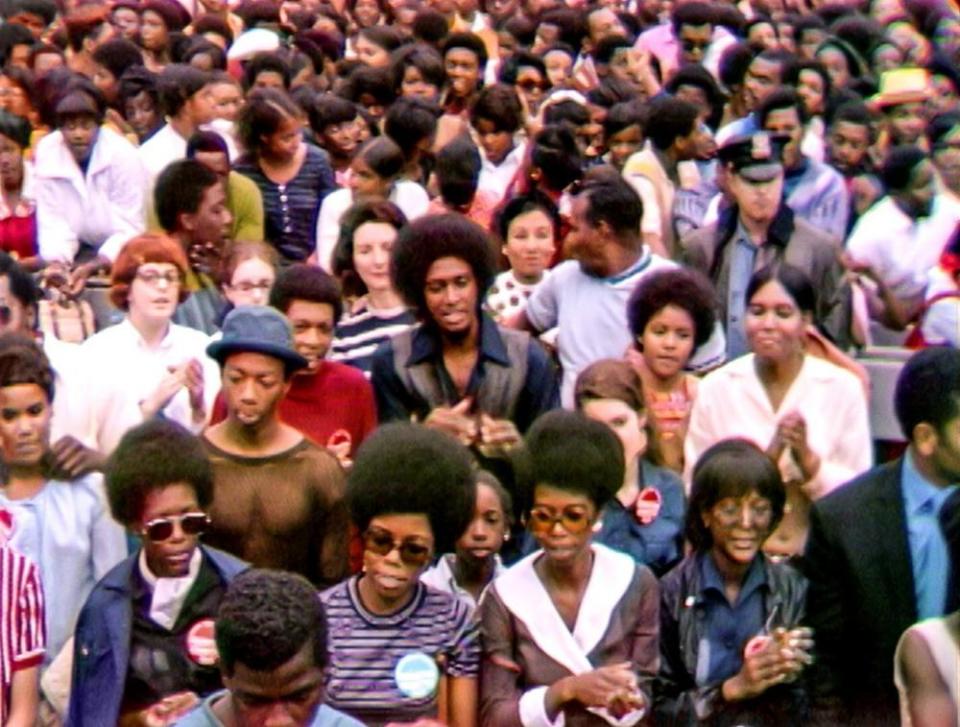Summer of Soul review – the best concert film ever made?

This Sundance award-winner is an absolute joy, uncovering a treasure trove of pulse-racing, heart-stopping live music footage (originally captured by TV veteran Hal Tulchin) that has remained largely unseen for half a century. While Mike Wadleigh’s Woodstock and the Maysles’ Gimme Shelter have long been considered definitive documents of the highs and lows of 1969 pop culture, Summer of Soul makes both look like a footnote to the main event: a festival in the heart of Harlem that was somehow written out of the history books. Capturing Stevie Wonder at a turning point in his career, Mavis Staples duetting with Mahalia Jackson (“an unreal moment”, says Staples) and Nina Simone at the height of her performing powers, director Ahmir “Questlove” Thompson’s feature debut intertwines music and politics in one of the best concert movies of all time.
Produced and MCed by Tony Lawrence (“a hustler, in the best sense”), and supported by the liberal Republican New York mayor, John Lindsay, with security by the Black Panthers, the 1969 Harlem Cultural festival played out over six weekends in Mount Morris Park at a time of profound cultural re-evaluation, a year on from the assassination of Dr Martin Luther King. Up in space, Neil Armstrong may have been taking one small step for a man, but as a festivalgoer states: “Never mind the moon, let’s get some of that cash in Harlem.”
Astutely chosen news footage outlines a decade of tension, producing disparate strands of resistance – civil rights and Black power. Among those on stage are the saxophonist Ben Branch, whom King spoke to immediately before his death, requesting that Branch play his favourite song, Precious Lord, Take My Hand. It’s that song that Staples and Jackson perform together in a moment that matches the ecstatic heights of Amazing Grace – another long-delayed music doc, covering Aretha Franklin’s 1972 performances at the New Temple Missionary Baptist Church in Los Angeles.

Blending wry laughter with piercing insight, interviewees explain how the word “Black” shifted from a fighting-talk term of abuse to one of self-determination and pride. Trailblazing journalist Charlayne Hunter-Gault remembers the battle she fought to get the New York Times to use “Black” rather than “negro”, while others describe festival power-couple Abbey Lincoln and Max Roach as being “unapologetically Black – they lived that phrase every day”.
Watching footage of her band the 5th Dimension performing Aquarius/Let the Sunshine In with tasseled orange suits, Marilyn McCoo remembers how they had been criticised for being “not Black enough”, and how happy they were to be there in Harlem, reclaiming their identity. Then to cap it all, we watch Nina Simone showcasing a new song, inspired by the stage production To Be Young Gifted and Black, performed in a voice that the Rev Al Sharpton astutely characterises as “somewhere between hope and mourning”.
While Simone is described as looking “like an African princess”, Hugh Masekela’s performance of Grazing in the Grass seems to transport the audience to another land, soaring from the parks of New York to distant plains. Elsewhere, Sly and the Family Stone embody the psychedelic Afrofuturist R&B vibe, with Rose Stone and Cynthia Robinson giving their bandleader a run for his money on keyboards and trumpet respectively, and the audience gradually accepting that a white drummer can kick it after all.
Gladys Knight recalls that “it wasn’t just about the music; we wanted progress”; the Edwin Hawkins Singers perform Oh, Happy Day in lime-green harmony; Ray Barretto and Mongo Santamaría bring the Latin-fusion beat; BB King cradles his guitar like a baby while he sings the blues; Rev Jesse Jackson speaks to the soul; and Stevie Wonder is on fire – on drums, keyboards and vocals – as he enters a new era of meaningful jazz funk.
Related: ‘The revolution could not be televised’: why were so many black concert films erased from history?
The fact that the “rose coming through cement” of this festival was overlooked for so long served as further evidence that “Black history is gonna be erased”. Yet Questlove’s film begins and ends with festivalgoer Musa Jackson viewing the uplifting reclaimed footage (a sly counterpoint to the horrorshow bookending of Gimme Shelter) and tearfully thanking the film-maker for proving to him that “I’m not crazy!” – that this really happened. Thanks to this terrific film, we can all share in that sense of wonder.

 Yahoo Movies
Yahoo Movies 
